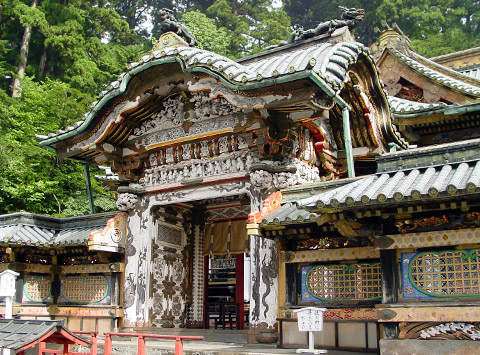Also
read karakado. A generic term for a gate with undulating bargeboards
*karahafu 唐破風. This term
includes *hirakaramon
平唐門 and *mukaikaramon
向唐門. The former has the characteristic bargeboards at each end, the latter
has them on front and back. Entrances are on the long sides and in both
types. The rafters also have the same undulation as the bargeboards. Usually,
the bargeboards and rafters form arcs that meet to form cusps called *ibara
茨. Therefore, the rafters are called ibaradaruki 茨垂木. Some karamon
have undulating gables, karahafu, on all four sides of the gate.
One example is at Nikkou Toushouguu 日光東照宮 in Tochigi prefecture. It is called
shihou karahafu-zukuri 四方唐破風造 or kara yotsuashimon 唐四脚門. The
word kara 唐, with reference to bargeboards on gates and
entrances does not necessarily point to a Chinese style but does indicate
the use of undulating bargeboards. The prefix kara is added to the
name of a gate that has a distinctive appellation or an ornate style. Karamon
are often placed at the entrance of monzeki 門跡 temples, headed by
a priest-price or in front of an abbot's quarters.
|



